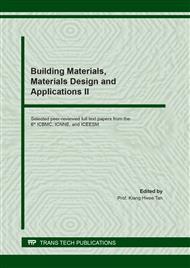p.87
p.99
p.111
p.119
p.129
p.141
p.149
p.157
p.165
A Method for Calculating Cracking Moment of FRP Reinforced Concrete Beam
Abstract:
This paper presents an analytical method for calculating the cracking moment of concrete beams reinforced with fiber reinforced polymer (FRP) bars, which considers the non-linear behavior of concrete in the tension zone and the contribution of FRP reinforcement. Theoretical cracking moments obtained by the proposed method were verified with the experimental results and the theoretical results calculated according to ACI 440.1R-15. The comparison results show good agreement between theoretical and experimental data. A parametric study on the effect of longitudinal FRP reinforcement ratio and elastic modulus of FRP on the cracking moment of FRP reinforced concrete beams also were done by using the proposed method. The parametric study results show that both longitudinal reinforcement and modulus of elasticity of FRP significantly affect the cracking moment of FRP reinforced concrete beams. Moreover, parametric study results also clarify the weakness of ACI 440.1R-15 in determining the cracking moment of concrete beams reinforced with a large amount of FRP reinforcement ratio and with high modulus of elasticity of FRP.
Info:
Periodical:
Pages:
141-147
Citation:
Online since:
August 2021
Authors:
Keywords:
Price:
Сopyright:
© 2021 Trans Tech Publications Ltd. All Rights Reserved
Share:
Citation:


